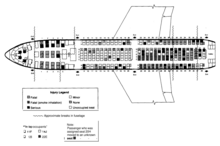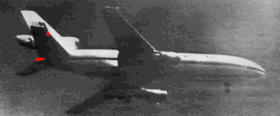United Airlines Flight 232
| United Airlines Flight 232 | |
|---|---|
|
The damaged machine; the damage is marked with red arrows. |
|
| Accident summary | |
| Accident type | Loss of control after engine failure |
| place | Sioux Gateway Airport , Sioux City , Iowa , USA |
| date | July 19, 1989 |
| Fatalities | 111 |
| Survivors | 185 |
| Injured | 172 |
| Aircraft | |
| Aircraft type | McDonnell Douglas DC-10-10 |
| operator | United Airlines |
| Mark | N1819U |
| Departure airport | Stapleton International Airport |
| Stopover |
O'Hare International Airport (planned, not reached) |
| Destination airport | Philadelphia International Airport |
| Passengers | 285 |
| crew | 11 |
| Lists of aviation accidents | |
On July 19, 1989, a McDonnell Douglas DC-10-10 on United Airlines Flight 232 ( flight number : UA232 or UAL232) suffered damage in the rear engine, causing the hydraulics to fail completely. The United Airlines plane , which was on a scheduled flight from Denver to Philadelphia , could then only be controlled by varying the thrust of the remaining two engines. The machine came off the runway during an emergency landing at Sioux Gateway Airport ( South Dakota ) , killing 110 of the 285 passengers and one flight attendant . Among the victims was the well-known chemist John Kenneth Stille .
Due to the extraordinary flying performance of the crew and a DC-10 flight instructor who happened to be on board the aircraft, 175 of the passengers and ten crew members survived the accident. By utilizing and coordinating all available resources during the emergency, the incident is an excellent example of successful Crew Resource Management (CRM).
course
The aircraft ( aircraft registration number: N1819U) took off at 2:09 p.m. CDT ( Central Daylight Time ) from Stapleton International Airport in Denver and was scheduled to fly to Philadelphia International Airport in Philadelphia with a stopover at O'Hare International Airport in Chicago . 15:16 the Fanlaufrad (fan disk) shattered the tail engine . The casing of the engine could not withstand the scattering debris. Some parts of the aircraft that had broken off when the fan wheel broke were later found in fields along the route. As a result, the debris also destroyed the machine's three independent hydraulic systems.
Captain Alfred C. Haynes and his crew soon noticed that the engine failure had also rendered all hydraulically operated controls virtually unusable. Since the manufacturer considered the failure of all hydraulic systems to be impossible at the same time, there was no longer any means of safely controlling the aircraft. As a result, the pilots could not keep it in a stable position over the long term, and the aircraft subsequently leaned sharply to the right. The reason for this was damage to the horizontal stabilizer, from which pieces were knocked out. Finally, the crew found out that the aircraft could still be controlled using the thrust of the two remaining engines on the wings. At this point, Dennis E. Fitch (1942-2012), a DC-10 flight instructor who flew privately as a passenger and was not part of the crew, offered his help. His task was to control the aircraft by using the thrust levers ; To do this, Fitch crouched behind the center console, from where he could operate the left thrust lever with his left hand and the right with his right hand in a differentiated and sensitive manner. In the meantime, an air emergency had been declared and an emergency landing at Sioux Gateway Airport had been agreed with air traffic control. The landing on the 2,743 m long runway 31 was originally planned. Increasing difficulties with the control required a landing on the shorter and inactive runway 22 with a length of 2,012 m and with fewer possibilities for maneuvering, but a lot of free space at the end of the runway.
Fitch also took over control during the approach to the airport by matching the engine power. Since the aircraft leaned to the right on final approach due to the damage to the tail unit, the edge curve of the right wing first touched the runway. The machine then flung to the right, broke apart and overturned. The cockpit was torn down, as was the front and rear of the fuselage. The central sector of the hull caught fire. Most of the victims died in it.
Crew performance
In subsequent reconstructions of the external circumstances of the accident in flight simulators , even experienced pilots did not succeed in repeating the great flying achievements of Fitch and Captain Hayne's crew in controlling the aircraft by changing the engine thrust to the runway. Even the factory test pilots in the simulator got no closer than 10 miles to the airport before losing control of the plane.
According to Fitch, test pilots tried to use the simulator at the training center in Denver to fly a DC-10 back to the airport without hydraulics or according to the data from the flight recorder. After 28 unsuccessful attempts, they came back to Fitch, who told them how to proceed; only then could they have landed the plane on the 29th attempt.
reasons
Detailed investigations revealed that the 17-year-old fan wheel broke because the airline had not discovered an existing fatigue crack during the routine maintenance of the machine . This failure, in turn, resulted from the fact that United Airlines had not adequately trained its maintenance personnel for this particular inspection and modern non-destructive materials testing methods such as ultrasound and eddy currents were not yet sufficiently developed. The main cause of the crack was a defect in the material ( blowholes ) in the impeller and was due to the metalworking supplier.
It turned out that there was a material defect in the manufacture of the semi-finished products for the titanium thrust gears . Nitrogen gas contaminating the parts was not removed. Titanium binds nitrogen in the melt very easily. If this contamination is not prevented, it can lead to a systematic drop in metal hardness over time - leading to failure. Newer series production uses a triple vacuum melting method to prevent this. During the subsequent investigation, a few titanium fan impellers from the same series were discovered in other aircraft. These too showed initial symptoms of the part defect.
As a result of the accident, other aircraft were modified to include additional safety devices that can operate at least some of the controls, even if all three hydraulic systems fail.
Increased chances of survival

Of the 296 people on board the machine, 111 (including 11 children) died during the landing or later succumbed to their injuries. 185 people survived the accident. Captain Haynes later named three decisive factors that increased the chances of survival and which all had to do with the specific time of the accident:
- The accident happened in daylight.
- The accident occurred during a shift change, both at the accident clinic for the area around Sioux City and at the special clinic for burn injuries - as a result, more medical staff were available to care for the injured.
- The accident occurred while the Iowa National Guard was at Sioux Gateway Airport for work, so 285 skilled workers could help with the care and removal of the injured.
Other reasons were that the rescue workers had enough time to get into position and were on the spot immediately after the crash. In addition, the interplay of the "three-state rescue network", which had previously been trained in exercises by the disaster committee under the direction of Gary Brown, was exactly the case of an emergency landing of a wide-body aircraft on the inactive runway 22 two years before the approach of UA232 been practiced. The practiced rescue chain of all available emergency services from three states worked in an exemplary manner and it was the cause of the large number of survivors.
The most important reason, however, was that the crew, led by Captain Haynes, managed to keep the aircraft stable in the air for such a long time and to still reach the airfield.
The 1994 memorial
In memory of the heroic rescue efforts demonstrated by the city of Sioux City after the accident, a statue was erected showing Colonel Dennis Nielsen bringing three-year-old survivor Spencer Bailey to safety. The memorial is part of a new development on the banks of the Missouri River . It can be reached via an avenue with memorial plaques commemorating the victims of the tragic event.
Reporting and reception
The accident is one of the most noticed in American aviation history, as a television team from the local broadcaster KTIV filmed the aircraft's attempt to land near the tarmac .
The event is the subject of a television film from 1992 with the title " Katastrophenflug 232 " and was also used for an episode of the American television series " Seconds From Disaster ", in which the accident was analyzed in detail.
See also
- Japan Airlines flight 123 , on which a Boeing 747 crashed due to similar control problems.
- Baikal Airlines Flight 130 on which the hydraulic systems of a Tu-154 failed.
- Shelling of the Airbus A300 OO-DLL of European Air Transport
- Aeroflot flight 3519 , A Tupolev Tu-154 also suffered uncontrolled engine damage due to a material fault in one of the engine parts, which ultimately caused the aircraft to crash.
Web links
- www.airdisaster.com - Investigation report of the NTSB (English, PDF, 3.5 MiB)
- Voice recorder manuscript (English, PDF, 187 KiB)
- Recording of the voice recorder at the time of service
- Interview with one of the pilots (1991) and protocol of the radio communication with the ground (English)
- Detailed description of the accident ( Memento from April 18, 2001 in the Internet Archive )
- Five-part video recording from "Seconds From Disaster", including interviews with the people involved ( YouTube video)
- The Impossible Landing - DC-10 Crash - New Flight Simulator 2017 (P3D 4.0 - Ultra Realism) TheFlightChannel, youtube.com, 2017, accessed April 1, 2018. Video (12:39), simulation, explanatory text in English, photo end position.
Individual evidence
- ^ A b The Crash of United Flight 232 . In: yarchive.net . May 24, 1991. (English). Interview with one of the pilots.
- ↑ Interview with Fitch in a documentation about flight UA232 on Youtube
- ↑ Emergency crews hold disaster drill on Flight 232 crash anniversary ( memento from April 2, 2015 in the Internet Archive ), ktiv.com from July 20, 2012, accessed on April 12, 2014 (English).
- ↑ SIOUX CITY TV STATION ANGERED OVER USE OF CRASH FOOTAGE , AP news archive online from July 22, 1989, accessed on April 12, 2014 (English).

